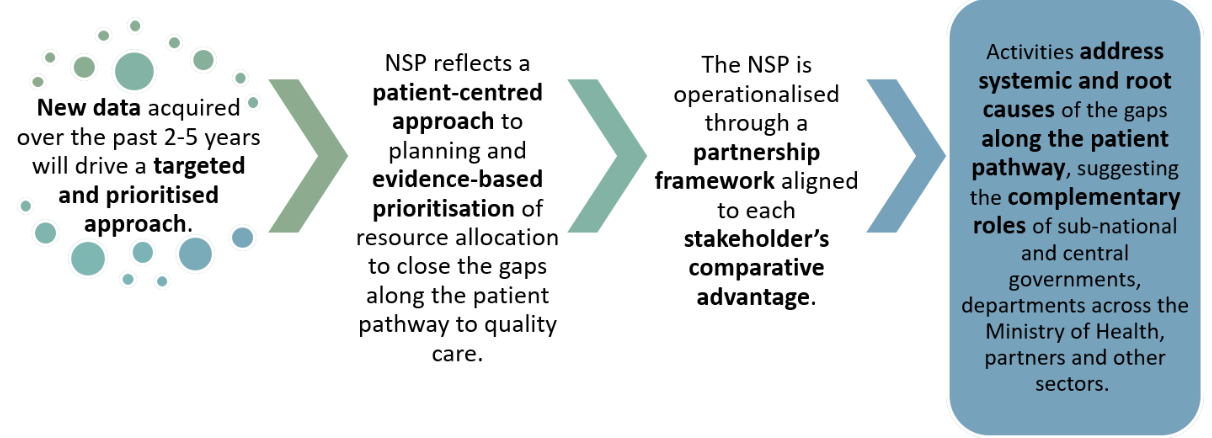The fight against tuberculosis (TB) is at a defining moment in its history. Global political will is at a high since countries at the 2018 United Nations High Level Meeting (UNHLM) have affirmed their political will towards the ambitious third SDG and the global End TB strategy. The Lancet Commission on Tuberculosis has emphasized the need to “explore how countries can improve outcomes and optimize use of available resources by realigning them to ensure that all tuberculosis care is people-centered and by prioritizing interventions that increase efficiencies in the delivery of tuberculosis services.”
Global TB surveillance data however suggests that targets for TB control set by the End TB strategy and the SDGs are steadily moving out of reach, as national program gains are progressing much slower than necessary. The gap between estimated numbers of TB patients and those ultimately found and provided with adequate care is slowly decreasing, but it is not sufficient to get on top of the epidemic, end transmission and eliminate unnecessary suffering.The fight against tuberculosis (TB) is at a defining moment in its history.
Global political will is at a high since countries at the 2018 United Nations High Level Meeting (UNHLM) have affirmed their political will towards the ambitious third SDG and the global End TB strategy. The Lancet Commission on Tuberculosis has emphasized the need to “explore how countries can improve outcomes and optimize use of available resources by realigning them to ensure that all tuberculosis care is people-centered and by prioritizing interventions that increase efficiencies in the delivery of tuberculosis services.”

DELIVERY OF PEOPLE-CENTERED TB SERVICES
Optimization can be reached through realigning and prioritizing intervention packages that increase efficiencies in the delivery of people-centered TB services, closer to where they should be delivered to meet patient preferences. Substantial investments in data systems, surveys, and tools have led to the availability of national and sub-national data that are comprehensive, current and usable. An unprecedented opportunity to use data on epidemiology, health system capacities and patient care seeking behavior is now in our hands to drive programmatic impact towards TB elimination. However, without rigorous synthesis and analysis, various sources of data can be overwhelming and not lead to evidence-based programming.
A JOINT EFFORT
The People-Centered Framework for TB programming: Development of Optimized National Strategic Plans was jointly developed by the Bill & Melinda Gates Foundation (the foundation), The Royal Tropical Institute Netherlands (KIT), the World Health Organization (WHO), Linksbridge SPC, TB MAC and refined by KNCV Tuberculosis Foundation (KNCV) to provide countries with the necessary tools and approaches to optimize their National Strategic Plans (NSP) in line with the End TB Strategy, SDGs and country commitments. You can find the pCF handbook, the toolkit and everything else you need on the dedicated PCF website.
The technical assistance for the NSP development process will be supported by the foundation, and planned and executed by KNCV as the lead technical partner in close collaboration with WHO (global, regional and country level), the Global Fund (TB team, modelling, health finance and economics experts, etc.), Linksbridge, and TB MAC; all of which will fulfil critical roles in supporting and vetting this approach.
The Philosophy:

OPTIMIZATION & RESOURCE ALLOCATION
The approach generates and utilizes local evidence in a participatory manner and applies tried and tested targeted impact and cost-effectiveness modelling to help stakeholders to select an optimized set of proven people-centered interventions and targets in terms of both future health and economic outcomes, based on their available and projected resources. At this stage, a country may want to consider several resource scenarios; e.g. existing funding levels, increased funding, or an aspirational / fully financed budget. Under each scenario, the package of interventions that most effectively and efficiently targets root causes and priority problems will need to be determined. The budget with existing funding levels can be used for immediate action, while the other budget tiers can be used as the basis for future funding requests.
Framework for prioritization and planning:

A ROBUST NATIONAL RESPONSE
The resulting NSPs will enable countries to use the generated evidence and evidence-based strategies to negotiate harmonized and optimized engagement and resource allocations from domestic and external stakeholders alike. These NSPs would be the basis of a robust national response towards ending TB in line with the End TB Strategy and overall national moves towards Universal Health Coverage (UHC). The resulting NSPs will also enable countries to follow an accelerated Global Fund application process under the new application format tailored to respective country NSP.
Strategic Focus:



